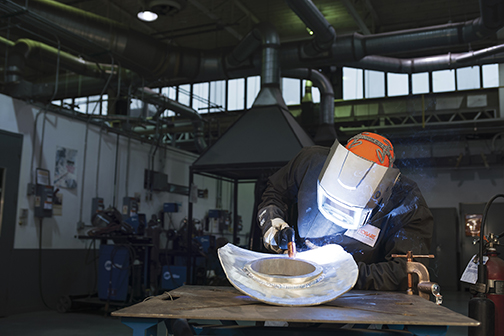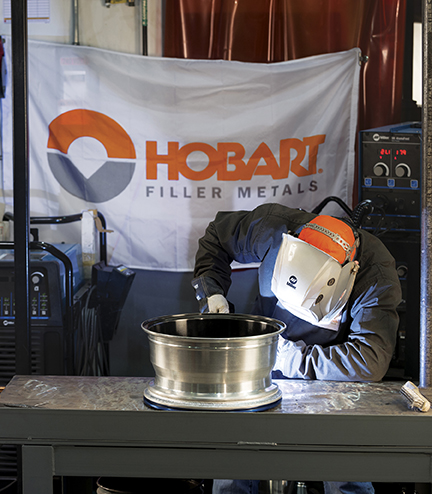Aluminum Welding: Getting to the Basics
Aluminum is relied on for its high strength-to-weight ratio and corrosion resistance, which makes it an attractive choice in industries such as transportation, automotive and aerospace, as well as general manufacturing and fabrication. It affords the opportunity to reduce the weight of completed parts without sacrificing their durability, and it can withstand more extreme service conditions than many other materials.
Aluminum’s high thermal conductivity adds to its appeal. It can be used for applications such as radiators or heat exchangers at a lower cost than copper, for example.
When welding aluminum, it’s important to establish the basics to gain the best results. From understanding potential pitfalls to following best practices for pre-cleaning, setting up equipment and more, each contributes to higher-quality welds and supports good productivity. Knowing the basics can also help prevent costly downtime for rework.
The challenges
Due to its high thermal conductivity, aluminum must be welded at relatively high parameters, which increases the potential for burn-through on thinner sections.This characteristic also makes aluminum prone to incomplete fusion at the start of welds (since the rest of the base material pulls away the heat so quickly) and makes crater fill difficult at the end of the weld. Power sources with adaptive features are available to help prevent these two issues. Welding slowly at the beginning of the weld and increasing the contact tip-to-work distance (CTWD) at the end can also help.
Porosity is another common problem when welding aluminum and can be caused by improper base material preparation, the presence of contaminants (e.g., dirt, oil, grease or paint), filler metals exposed to moisture, loose gas connections and shielding gas contamination. The presence of hydrogen in the weld pool — from the filler metal and the aluminum itself — can lead to porosity too. Hydrogen is very soluble in aluminum and can easily become trapped as the weld solidifies.
Hot cracking is another challenge aluminum welding presents and is a matter of chemistry as opposed to mechanical stresses. Certain aluminum alloys, such as 6000 series, are more susceptible to hot cracking. The filler metal used also influences the opportunity for this issue, so it’s important to choose one with lower crack sensitivity if that is a concern.
Lastly, restrictive joint designs can contribute to hot cracking. For that reason, it is important that the joint is wide enough to be able to reduce the stresses that the aluminum weld metal undergoes during the welding process.
Cleaning and preparation
Aluminum’s surface contains an oxide layer that must be removed prior to welding. This thin, hard layer provides the material with its corrosion resistance, but it also melts at a higher temperature than the aluminum below (3,700 versus 1,221 degrees Fahrenheit). Because of that difference in temperature, the oxide layer can cause penetration issues during welding.
To begin aluminum welding preparation, thoroughly wipe the surface of the material with a clean cloth and a solvent — such as acetone — that cleans well and is able to effectively degrease the base material. When using flammable liquids like acetone, be sure to work in an area away from the weld cell to avoid the risk of fire. Never use any liquid containing chlorine to clean aluminum, as chlorine becomes toxic when exposed to the heat of the arc.
Using a stainless-steel brush or grinding wheel dedicated to the purpose of cleaning the aluminum, brush or grind the surface to remove the oxide layer. Because the oxide layer will start forming as soon as the exposed aluminum comes in contact with air, take care of this step as close as possible prior to welding.
Although it isn’t necessary, you can wipe down the surface with the clean cloth and acetone again to remove any shavings.
Equipment and consumables
Aluminum welding setup varies compared to other materials. In the MIG welding process, for example, the aluminum welding wire is very soft and subject to deformation and wire shaving during feeding. To prevent this, it is important to use the proper equipment and consumables.
In addition to a power source specifically designed for welding aluminum, U-grooved drive rolls and non-metallic inlet guides for the wire feeder help ensure good weld quality. These components provide smooth wire feeding and prevent wire shaving. Welding operators should set the lightest drive roll tension that will still feed the wire.
Use a push-pull gun and a non-metallic Teflon® liner, along with contact tips designed specifically for welding aluminum. If these contact tips are not available, a standard copper contact tip with a bore diameter approximately 10% larger than the wire diameter can work to reduce wire shaving, while still providing the appropriate electrical conductivity to create a stable arc.

and corrosion resistance, which makes it an attractive
choice in a variety of industries.
Welding parameters and techniques
MIG welding aluminum settings will vary with the diameter of welding wire being used, as well as the thickness of the aluminum base material. Consult the filler metal spec sheet for recommendations on amperage, voltage and wire feed speed.
To gain consistent arc characteristics, use argon or an argon/helium mix. Note that the addition of helium provides greater penetration and a wider bead profile when used on thicker sections of aluminum; however, helium more expensive than argon and creates a slightly less stable arc. The needs of the application will determine whether helium’s additional cost is worthwhile compared to changing joint design or making other adjustments.
There are key aluminum welding techniques that provide the best success. When welding with aluminum solid wire, using a push angle creates a wider weld bead and good tie-in at the toes of the weld. Compared to steel, aluminum’s greater thermal conductivity may require not only higher current or voltage, but also faster travel speeds. Because of this, the term “hot and fast” is often used to refer to aluminum welding.
Filler metal considerations
Filler metal selection for aluminum varies based on the alloy being welded and the desired properties of the finished weld. It’s important to consider how the filler metal will perform in terms of:
1. Crack sensitivity
2. Strength
3. Ductility
4. Corrosion resistance
5. Elevated service temperatures
6. Color match after anodizing
7. Post-weld heat treatment (PWHT)
8. Toughness
Filler metal manufacturers often offer selection charts that can help match specific aluminum alloys to the proper filler metal based on the weld’s requirement. That said, welding wires designated as 4043 and 5356 are among the most common options. 4943 filler metals also offer some unique characteristics that make them a desirable substitute for 4043 products.
4043 aluminum filler metals offer a fluid weld pool (from the addition of 5% silicon), which improves their wetting action or flow into the joint, helps minimize cracking and reduces the need for extra post-weld cleaning. 5356 filler metals contain magnesium, which increases toughness and strength; however, it also creates more smut (black soot) at the toes of the weld that will require post-weld cleaning.
Using 4943 filler metal instead of a 4043 aluminum product offers benefits such as higher strength with comparable weldability and crack resistance. The addition of magnesium is the source of the higher as-welded strength, which it provides without relying on dilution of the aluminum itself. That means the filler metal does not need to combine with the elements in the base material to gain the desired chemical and mechanical properties, including strength.
Parting thoughts
Welding operations, when working with aluminum, can benefit from establishing some basic best practices. Cleanliness and proper material preparation, in particular, are among the most important first steps to success. In addition, always remember to follow manufacturers’ recommendations for power source and gun setup and consumables installation to gain the highest weld quality. Follow recommended safety instructions as well.



